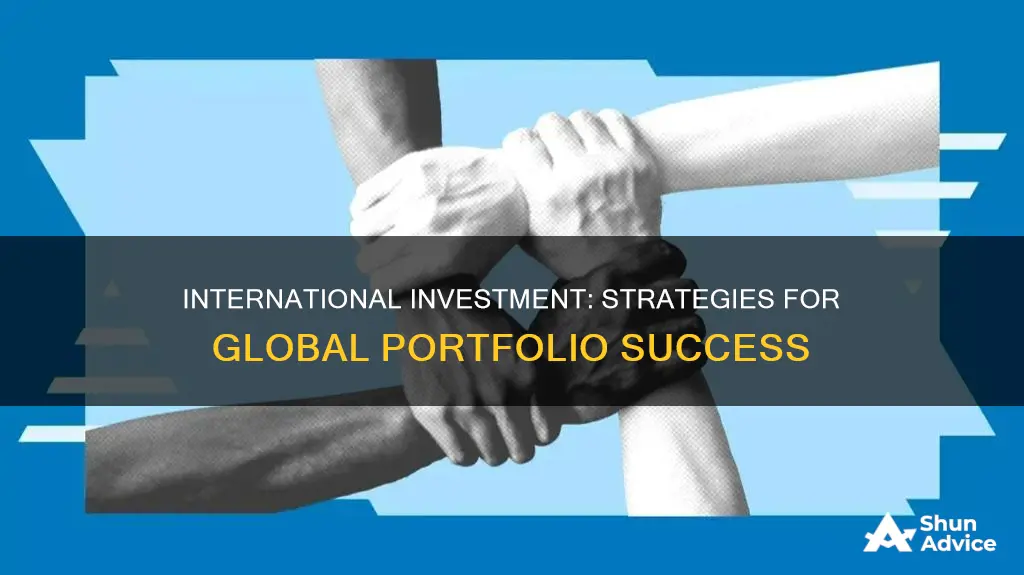
International investment is an important aspect of the global economy, allowing investors to expand their portfolios beyond their home country's borders. It involves investing in foreign companies, markets, or financial instruments such as stocks, bonds, and mutual funds. By diversifying their investments internationally, investors aim to achieve higher returns, access new markets, and reduce risk through geographical diversification. However, it's important to note that international investment also comes with challenges, including political instability, currency fluctuations, and varying regulatory environments. In this topic, we will explore the different types of international investments, their benefits, risks, and how investors can navigate the complex landscape of investing in foreign markets.
| Characteristics | Values |
|---|---|
| Types of International Investment | Foreign Direct Investment (FDI), Foreign Portfolio Investment (FPI) |
| Main Reasons | Diversification, Growth |
| Risks | Currency fluctuations, Political and economic stability, Liquidity, Costs, Market value changes, Information access, Legal remedies, Market operations |
| How to Invest | Mutual funds, Exchange-traded funds (ETFs), American Depositary Receipts (ADRs), U.S.-Registered Mutual Funds, U.S.-Registered Exchange-Traded Funds (ETFs), U.S.-traded foreign stocks, Trading on Foreign Markets |
What You'll Learn

Foreign Direct Investment (FDI)
FDI can be made in several ways, including:
- Opening a subsidiary or associate company in a foreign country
- Acquiring a controlling interest in an existing foreign company
- Merging with a foreign company
- Joint ventures with a foreign company
FDI is a significant aspect of the global economy, fostering economic growth and providing investors with diverse opportunities to increase their wealth. It also helps to promote interdependence among nations, stability, and fair trade and investment practices. FDI can also lead to job creation, technology advancements, and increased productivity in the recipient country.
There are three types of FDI:
- Horizontal FDI: A company establishes the same type of business operation in a foreign country as it operates in its home country.
- Vertical FDI: A business acquires a complementary business in another country, such as a supplier of raw materials.
- Conglomerate FDI: A company invests in a foreign business unrelated to its core business, often in the form of a joint venture.
The threshold for establishing a controlling interest in a foreign company through FDI is typically a minimum of 10% ownership stake, according to guidelines set by the Organisation for Economic Co-operation and Development (OECD). However, effective control can sometimes be established with less than 10% of voting shares.
Balancing Your Investment Portfolio: Strategies for Success
You may want to see also

Foreign Portfolio Investment (FPI)
FPI is one of the most common ways for investors, especially retail investors, to participate in an overseas economy. It offers a quicker return on investment and is more liquid than Foreign Direct Investment (FDI). However, FPI money is susceptible to departing the country of investment during periods of uncertainty or negative news, which can further aggravate economic problems.
FPI investors aim to diversify their portfolios, spread risk, and tap into diverse economic growth opportunities worldwide. Factors such as economic stability, growth prospects, favourable regulatory environments, and the potential for attractive returns draw FPI into a country.
There are several categories of FPI, depending on the level of risk involved. These include:
- Category I (low risk): Financial assets backed by the government, such as government bonds, sovereign wealth funds, and state-owned funds.
- Category II (moderate risk): Bank deposits, mutual funds, insurance policies, pension funds, regulated banks, asset management companies, and investment trusts.
- Category III (high risk): All other FPIs that do not fall under the first two categories, such as charitable trusts, foundations, and individuals.
FPI is an important aspect of the global economy, fostering economic growth and providing investors with opportunities to increase their wealth. However, it also comes with challenges, including political instability, currency fluctuations, and varying regulatory environments across different countries.
Unit Trust: Managed Investment Scheme Explained
You may want to see also

International Mutual Funds
When choosing an international mutual fund, you have several options:
- International funds: These funds focus solely on foreign markets, excluding the investor's home country, such as the US.
- Global or world funds: This type of fund combines investments in both foreign markets and the investor's home country.
- Regional funds: Regional funds concentrate their investments in a specific part of the world, such as Europe or the Asia-Pacific region.
- Developed markets funds: These funds invest in foreign countries with established and proven economies, such as Japan, France, and the United Kingdom.
- Emerging markets funds: In contrast, emerging markets funds target developing economies, such as India, Brazil, and China, which are often experiencing rapid growth but carry higher risks.
It is recommended that at least 20% of your portfolio be invested in international stocks and bonds. However, for optimal diversification, Vanguard suggests considering allocating about 40% of your stock investments and 30% of your bond investments to international markets.
- American Funds EuroPacific Growth RERFX
- American Funds International Growth and Income IGAAX
- Artisan International Value ARTKX
- Causeway International Value CIVVX
- Dodge & Cox International Stock DOXFX
- Fidelity Total International Index FTIHX
- Goldman Sachs GQG Partners International Opportunities GSINX
- IShares Core MSCI Total International Stock ETF IXUS
- JPMorgan International Equity JIERX
- Vanguard FTSE All-World ex-US ETF VEU
- Vanguard International Dividend Appreciation ETF VIGI
Equity Investment: Strategies for Finding the Right Investors
You may want to see also

Exchange-Traded Funds (ETFs)
ETFs are a good option for international investment as they offer diversification, low costs, and the ability to trade shares live during the trading day. They are also tax-efficient, as they only add and remove securities when the index does so, which is rarely. This means there are usually few, if any, capital gains distributions to report at tax time.
ETFs can be purchased through online brokers and traditional broker-dealers, as well as in retirement accounts. Some sources recommend using a robo-advisor for this purpose.
There are many different types of ETFs available, including:
- Actively managed ETFs: These do not target an index; instead, portfolio managers make decisions about which securities to buy and sell. Actively managed ETFs have higher fees than passive ETFs.
- Passive ETFs: These aim to replicate the performance of a broader index, such as the S&P 500.
- Bond ETFs: These provide regular income to investors, depending on the performance of the underlying bonds.
- Industry or sector ETFs: These track a single industry or sector, like automotive or energy, and aim to provide diversified exposure to that industry.
- Commodity ETFs: These invest in commodities like crude oil or gold, and can be used to diversify a portfolio.
- Currency ETFs: These track the performance of currency pairs and can be used to speculate on exchange rates based on political and economic developments.
- Inverse ETFs: These allow investors to earn gains from stock declines without having to short stocks.
- Leveraged ETFs: These seek to return multiples on the return of the underlying investments (e.g., a 2x leveraged ETF will return 2% if the S&P 500 rises by 1%).
When considering an ETF for international investment, it is important to note that they are subject to the same risks as other international investments, including currency fluctuations, political and economic stability, and liquidity risks.
Legitimate Ways to Earn Money from Home in India
You may want to see also

American Depositary Receipts (ADRs)
ADRs offer several benefits to both US investors and foreign companies. For US investors, ADRs provide an easy and liquid way to invest in foreign stocks, diversifying their portfolios and giving them access to greater rewards and risks. They can purchase ADRs directly through American brokers, eliminating the need to go through foreign channels.
For foreign companies, ADRs offer an opportunity to attract American investors and capital without the hassle and expense of listing on US stock exchanges. By issuing ADRs, foreign companies can gain greater visibility in the international market, access a larger pool of investors, and receive coverage by more equity analysts.
There are two main types of ADRs: sponsored and unsponsored. Sponsored ADRs are issued by a bank on behalf of the foreign company, with a legal arrangement in place. The foreign company typically pays the costs of issuing and retains control, while the bank handles transactions with investors. Sponsored ADRs are categorised by the degree to which the foreign company complies with Securities and Exchange Commission (SEC) regulations and American accounting procedures.
Unsponsored ADRs, on the other hand, are issued without the direct involvement, participation, or permission of the foreign company. Multiple unsponsored ADRs for the same foreign company can be issued by different US banks, and they may offer varying dividends. Unsponsored ADRs never include voting rights and trade only over the counter.
ADRs may also be categorised into three levels based on the extent to which the foreign company has accessed the US markets. Level I ADRs have the loosest requirements from the SEC and are highly speculative, while Level II ADRs have slightly more requirements and offer higher visibility and trading volume. Level III ADRs are the most prestigious, allowing issuers to establish a substantial trading presence in the US financial markets and raise capital.
It is important to note that investing in ADRs may involve additional costs and the risk of double taxation, as well as exposure to currency exchange rate fluctuations.
Understanding Equity-Based Investment: What Investors Need to Know
You may want to see also
Frequently asked questions
There are two main types of international investment: Foreign Direct Investment (FDI) and Foreign Portfolio Investment (FPI). FDI involves acquiring a controlling stake in a foreign company or establishing business operations in another country. FPI, on the other hand, involves investing in foreign financial assets like stocks and bonds without seeking control.
International investment offers the advantage of diversification, allowing investors to spread their risk across various countries and markets. It also provides access to emerging markets and the potential for higher returns due to the growth of foreign economies.
Vanguard, a well-known investment firm, recommends allocating at least 20% of your overall portfolio to international stocks and bonds. For optimal diversification, consider investing about 40% of your stock allocation and 30% of your bond allocation internationally.
International investment carries specific risks, including political instability, currency fluctuations, varying regulatory environments, and economic and social events. Additionally, there may be challenges in accessing information, higher costs, and differences in market operations and liquidity levels compared to domestic investments.
You can begin by investing in international mutual funds or exchange-traded funds (ETFs), which provide instant diversification and are generally more cost-effective. Alternatively, you can directly purchase foreign stocks and bonds, but this may require a better understanding of foreign markets and involve higher costs.







